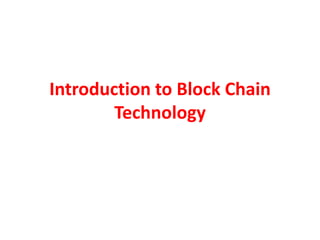
Introduction to Distributed Systems
- 1. Introduction to Block Chain Technology
- 2. Definition of a Distributed System A distributed system is a collection of independent computers that appears to its users as a single coherent system .... or ... as a single system.
- 3. Resource Sharing and the Web • Hardware resources (reduce costs) • Data resources (shared usage of information) • Service resources • search engines • computer-supported cooperative working • Service vs. server (node or process )
- 4. Distributed application • one single “system” • one or several autonomous subsystems • a collection of processors • parallel processing • Increased performance, reliability, fault tolerance • partitioned or replicated data • increased performance, reliability, fault tolerance • Dependable systems, grid systems, enterprise systems
- 5. Why Distribution? • Sharing of information and services • Possibility to add components improves • Availability • Reliability • fault tolerance • performance • scalability
- 6. Goals of DS • Making resources accessible • Distribution transparency • Openness • Scalability • Security • System design requirements
- 7. Challenges for Making Resources Accessible • Naming • Access control • Security • Availability • Performance • Mutual exclusion of users, fairness • Consistency in some cases
- 8. Transparencies • Access : Hide differences in data representation and how a resource is accessed • Location: Hide where a resource is located • Migration : Hide that a resource may move to another location • Relocation : Hide that a resource may be moved to another locationwhile in use (the others don’t notice) • Replication :Hide that a resource is replicated • Concurrency :Hide that a resource may be shared by severalcompetitive users • Failure :Hide the failure and recovery of a resource • Persistence: Hide whether a (software) resource is in memory or ondisk
- 9. Omission and arbitrary failures • Fail-stop:Process halts and remains halted. Other processes may detect this state. • Crash:Process halts and remains halted. Other processes may not be able to detect thisstate. • Omission:A message inserted in an outgoing message buffer never arrives at the otherend’s incoming message buffer. • Send-omission:A process completes send, but the message is not put in its outgoingmessage buffer. • Receive-omission : A message is put in a process’s incoming message buffer, but that process does not receive it. • Arbitrary(Byzantine) :Process/channel exhibits arbitrary behaviour: it maysend/transmit arbitrary messages at arbitrary times, commit omissions; a process maystop or take an incorrect step
- 10. Timing failures • Clock: Process’s local clock exceeds the bounds on its rate of drift from real time. • Performance : Process exceeds the bounds on the interval between two steps. • Performance: A message’s transmission takes longer than the stated bound.
- 11. Failure Handling • More components • increased fault rate • Increased possibilities •more redundancy => more possibilities for fault tolerance • no centralized control => no fatal failure • Issues • Detecting failures • Masking failures • Recovery from failures • Tolerating failures • Redundancy • partial failures
- 12. Concurrency • Concurrency: • Several simultaneous users => integrity of data • mutual exclusion • synchronization • transaction processing in data bases • Replicated data: consistency of information? • Partitioned data: how to determine the state of the system? • Order of messages? • There is no global clock!
- 13. Challenges for Scalability • The system will remain effective when there is a significant increase in • number of resources • number of users • The architecture and the implementation must allow it • The algorithms must be efficient under the circumstances to be expected
- 14. Challenges for Security • Security: confidentiality, integrity, availability • Vulnerable components • channels (links <–> end-to-end paths) • processes (clients, servers, outsiders) • Threats • information leakage • integrity violation • denial of service • illegitimate usage • Current issues: • Denial-of-service attacks, security of mobile code, information flow; • open wireless ad-hoc environments
- 15. Security Model
- 16. • Threats to channels • eavesdropping (data, traffic) • tampering, replaying • masquerading • denial of service • Threats to processes • server: client’s identity; • client: server’s identity • unauthorized access (insecure access model) • unauthorized information flow (insecure flow model)
- 18. Defeating Security Threats • Techniques • Cryptography • authentication • access control techniques • intranet: firewalls • services, objects: access control lists, capabilities • Policies • access control models • lattice models • information flow models • Leads to: secure channels, secure processes, controlled access,controlled flows
- 19. Distributed systems • Distributed systems are a computing paradigm whereby two or more nodes work with each other in a coordinated fashion in order to achieve a common outcome • DS modeled in such a way that end users see it as a single logical platform • Node can be defined as an individual player in a distributed system and have their own memory and processor. • All nodes are capable of sending and receiving messages to and from each other. • Nodes can be honest, faulty, or malicious
- 20. • A node that can exhibit arbitrary behavior is also known as a Byzantine node. • This arbitrary behavior can be intentionally malicious, which is detrimental to the operation of the network. • Generally, any unexpected behavior of a node on the network can be categorized as Byzantine.
- 21. Challenge in distributed system Design • Coordination between nodes • Fault tolerance • Even if some of the nodes become faulty or network links break, the distributed system should tolerate • D S should continue to work flawlessly in order to achieve the desired result. • Several algorithms and mechanisms has been proposed to overcome these issues. • Distributed systems are so challenging to design that a theorem known as the CAP theorem has been proved and states that a distributed system cannot have all much desired properties simultaneously.